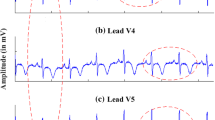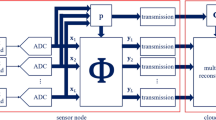Abstract
Electrocardiogram (ECG) data compression has numerous applications. The time for generating compressed samples is a vital factor when we consider ambulatory devices, with the fact that data should be sent to the physician as soon as possible. In addition, there are some wearable ECG recorders that have limited power, and may only be capable of doing simple algorithms. With the aim of increasing the speed and simplicity of the compressors, we propose a system architecture that can generate compressed ECG samples, in a linear method and with CR 75%. We used sparsity of the ECG signal and proposed a system based on compressed sensing (CS) that can compress ECG samples, almost in real-time. We applied CS in a very small size in order to accelerate the compression phase and accordingly reducing the power consumption. Also, in the recovery phase, we used the recently developed Kronecker technique to improve the quality of the recovered signal. The system designed based on full-adder/subtractor (FAS) and shift registers, without using any external processor or any training algorithm.








Similar content being viewed by others
References
MalekpourShahraki M, Barghi H, Azhari SV, Asaiyan S. Distributed and energy efficient scheduling for IEEE802. 11s wireless EDCA networks. Wirel Pers Commun. 2016;90(1):301–23.
Malekpourshahraki M, Stephens B, Vamanan B. Ether: providing both interactive service and fairness in multi-tenant datacenters. In: Proceedings of the 3rd Asia-Pacific workshop on networking 2019. ACM; 2019. p. 50–6.
Izadi V, Abedi M, Bolandi H. Supervisory algorithm based on reaction wheel modelling and spectrum analysis for detection and classification of electromechanical faults. IET Sci Meas Technol. 2017;11(8):1085–93.
Mamaghanian H, Khaled N, Atienza D, Vandergheynst P. Compressed sensing for real-time energy-efficient ECG compression on wireless body sensor nodes. IEEE Trans Biomed Eng. 2011;58(9):2456–66.
Ravelomanantsoa A, Rabah H, Rouane A. Compressed sensing: a simple deterministic measurement matrix and a fast recovery algorithm. IEEE Trans Instrum Meas. 2015;64(12):3405–13.
Izadi V, Abedi M, Bolandi H. Verification of reaction wheel functional model in hil test-bed. In: 2016 4th international conference on control, instrumentation, and automation (ICCIA). IEEE; 2016. p. 155–60.
Singh A, Dandapat S. Block sparsity-based joint compressed sensing recovery of multi-channel ecg signals. Healthc Technol Lett. 2017;4(2):50–6.
Lu DYKZ, Pearlman WA. Wavelet compression of ecg signals by the set partitioning in hierarchical trees algorithm. IEEE Trans Biomed Eng. 2000;47(7):849–56.
Wei N-KCJ-J, Chang C-J, Jan G-J. ECG data compression using truncated singular value decomposition. IEEE Trans Inf Technol Biomed. 2001;5(4):849–56.
Hilton ML. Wavelet and wavelet packet compression of electrocardiograms. IEEE Trans Biomed Eng. 1997;44(5):394–402.
Zigel Y, Cohen A, Katz A. The weighted diagnostic distortion (WDD) measure for ECG signal compression. IEEE Trans Biomed Eng. 2000;47(11):1422–30.
Zhang J, Zhao D, Zhao C, Xiong R, Ma S, Gao W. Image compressive sensing recovery via collaborative sparsity. IEEE J Emerging Sel Top Circuits Syst. 2012;2(3):380–91.
Ujan S, Ghorshi S, Pourebrahim M, Khoshnevis SA. On the use of compressive sensing for image enhancement. In: 2016 UKSim-AMSS 18th international conference on computer modelling and simulation (UKSim); 2016. p. 167–71.
Ender JH. On compressive sensing applied to radar. Signal Process. 2010;90(5):1402–14.
Baraniuk R, Steeghs P. Compressive radar imaging. In: 2007 IEEE radar conference. IEEE; 2007. p. 128–33.
Talkhouncheh RG, Khoshnevis SA, Aboutalebi SA, Surakanti SR. Embedding wireless intelligent sensors based on compact measurement for structural health monitoring using improved compressive sensing-based data loss recovery algorithm. Int J Mod Trends Sci Technol. 2019;5(7):1–6.
Taremi RS, Shahri PK, Kalareh AY. Design a tracking control law for the nonlinear continuous time fuzzy polynomial systems. J Soft Comput Decis Support Syst. 2019;6:21–7.
Shahri PK, Shindgikar SC, HomChaudhuri B, Ghasemi A. Optimal Lane Management in Heterogeneous Traffic Network. In: Proceedings of the ASMA dynamic systems and control conference in Park City, Utah 2019.
Engan K, Aase SO, Husøy JH. Multi-frame compression: theory and design. Signal Process. 2000;80(10):2121–40.
Lingala SG, Jacob M. Blind compressive sensing dynamic MRI. IEEE Trans Med Imaging. 2013;32(6):1132–45.
Donoho DL. Compressed sensing. IEEE Trans Inf Theory. 2006;52(4):1289–306.
Candès EJ. The restricted isometry property and its implications for compressed sensing. C R Math. 2008;346(9–10):589–92.
Chen SS, Donoho DL, Saunders MA. Atomic decomposition by basis pursuit. Soc Ind Appl Math. 2001;43(1):129–59.
Tropp JA, Gilbert AC. Signal recovery from random measurements via orthogonal matching pursuit. IEEE Trans Inf Theory. 2007;53(12):4655–66.
Do TT, Gan L, Nguyen N, Tran TD. Sparsity adaptive matching pursuit algorithm for practical compressed sensing. In: 2008 42nd Asilomar conference on signals, systems and computers; 2008. p. 581–7.
Mohimani H, Babaie-Zadeh M, Jutten C. A fast approach for overcomplete sparse decomposition based on smoothed \(\ell ^{0}\) norm. IEEE Trans Signal Process. 2009;57(1):289–301.
Zanddizari H, Rajan S, Zarrabi H. Increasing the quality of reconstructed signal in compressive sensing utilizing Kronecker technique. Biomed Eng Lett. 2018;8(2):239–47.
Khoshnevis SA, Ghorshi S. Recovery of event related potential signals using compressive sensing and kronecker technique. In: 2019 IEEE global conference on signal and information processing (GlobalSIP) (GlobalSIP 2019), Ottawa, Canada; 2019.
Mitra D, Zanddizari H, Rajan S. Improvement of recovery in segmentation-based parallel compressive sensing. In: 2018 IEEE international symposium on signal processing and information technology (ISSPIT); 2018. p. 501–6.
Mitra D, Zanddizari H, Rajan S. Improvement of signal quality during recovery of compressively sensed ECG signals. In: 2018 IEEE international symposium on medical measurements and applications (MeMeA); 2018. p. 1–5.
Surakanti SR, Emami M, Zahedi L. Compression of speech signals using Kronecker enhanced compressive sensing method. In: 5th conference on signal processing and intelligent systems; 2019. p. 1–5.
MIT–BIH Arrhythmia Database. http://www.physionet.org/physiobank/database/mitdb/
Mitra D, Zanddizari H, Rajan S. Investigation of Kronecker-based recovery of compressed ECG measurements. Preprint. https://doi.org/10.13140/RG.2.2.16740.22400
Author information
Authors and Affiliations
Corresponding author
Ethics declarations
Conflict of interest
Vahid Izadi declares that he has no conflict of interest. Pouria Karimi Shahri declares that he has no conflict of interest. Hamed Ahani declares that he has no conflict of interest.
Ethical approval
This article does not contain any studies with human participants performed by any of the authors.
Additional information
Publisher's Note
Springer Nature remains neutral with regard to jurisdictional claims in published maps and institutional affiliations.
Rights and permissions
About this article
Cite this article
Izadi, V., Shahri, P.K. & Ahani, H. A compressed-sensing-based compressor for ECG. Biomed. Eng. Lett. 10, 299–307 (2020). https://doi.org/10.1007/s13534-020-00148-7
Received:
Revised:
Accepted:
Published:
Issue Date:
DOI: https://doi.org/10.1007/s13534-020-00148-7




